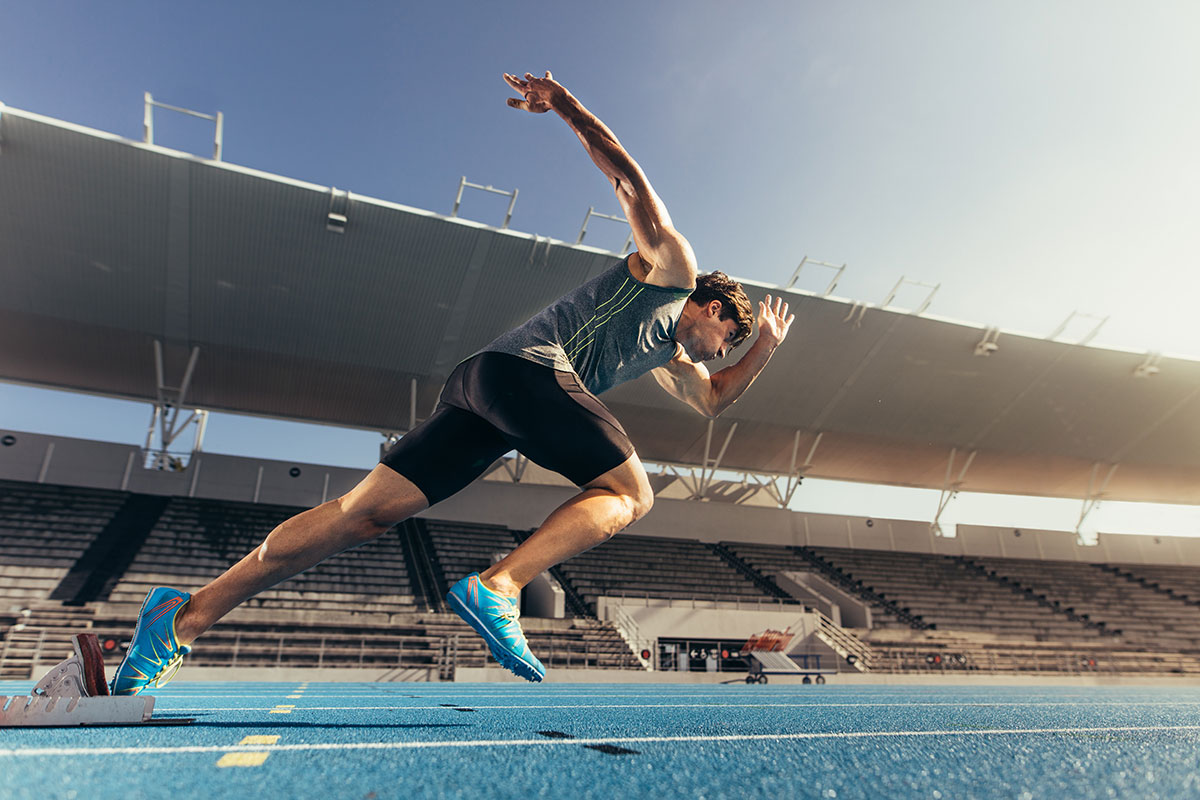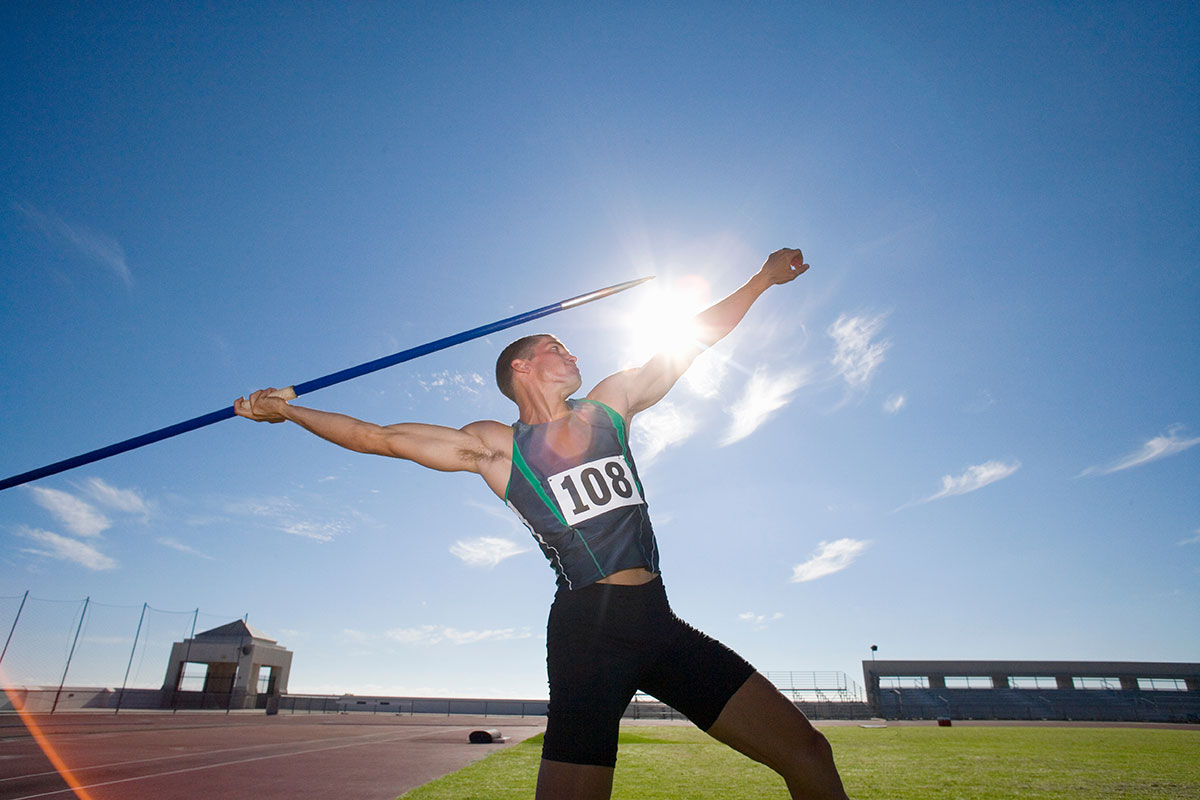World Athletics@TDK
[No.6 The decathlon and heptathlon] What is the decathlon and the heptathlon?
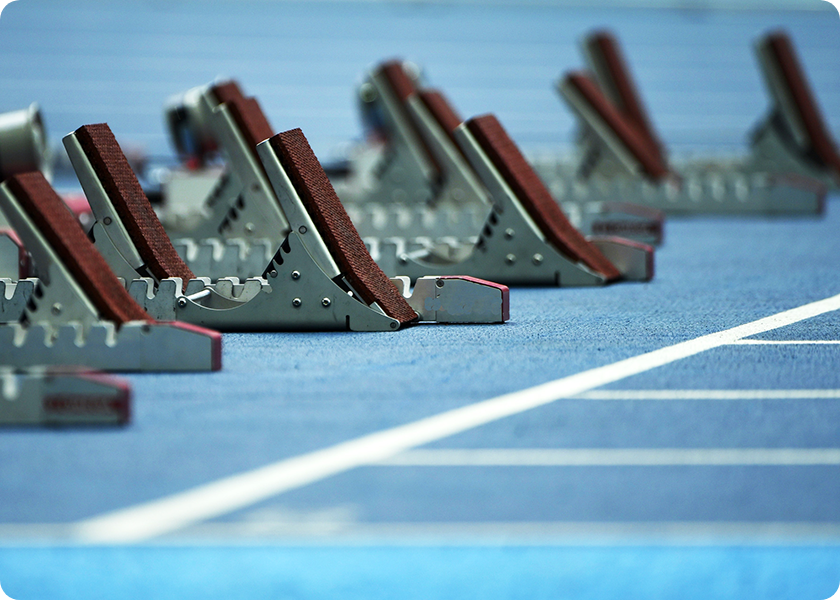
- Athletes compete in a combination of running, jumping, and throwing events for two days

- The world record in the heptathlon remains unbroken for over 30 years

- A stadium offers a unique experience of spectating at track and field events at one time

- TDK’s sensors and sensing technology, supporting sports science and athletes’ healthcare

Athletes compete in a combination of running, jumping, and throwing events for two days
The decathlon (men) and heptathlon (women) are sporting events fought with a combination of running, jumping, and throwing events. The winners are crowned with the titles of the King of Athletes and the Queen of Athletes, respectively.
These sports have their roots in the pentathlon held in the ancient Greek Olympics, which consisted of the long jump, discus throw, stadion run, javelin throw and wrestling. The word stadion in Greek means a straight alley of about 200m, and is the root of the word “stadium” in English. The suffix -athlon, as in decathlon and heptathlon, comes from the Greek word for “competition,” and some English words like athlete and athletics are also related to the word.
In the decathlon and heptathlon, the following events are competed in over two consecutive days. The sports require athletes to perform running, jumping, and throwing events one after another, as well as managing their time for warming up and practicing before the competition, and then cooling down and taking breaks between events, for which excellent physical competence and perseverance are vital prerequisites, as is mental toughness. For this reason, they are known as the hardest of all track and field sports. Of course, regular training is necessary for all of the events.
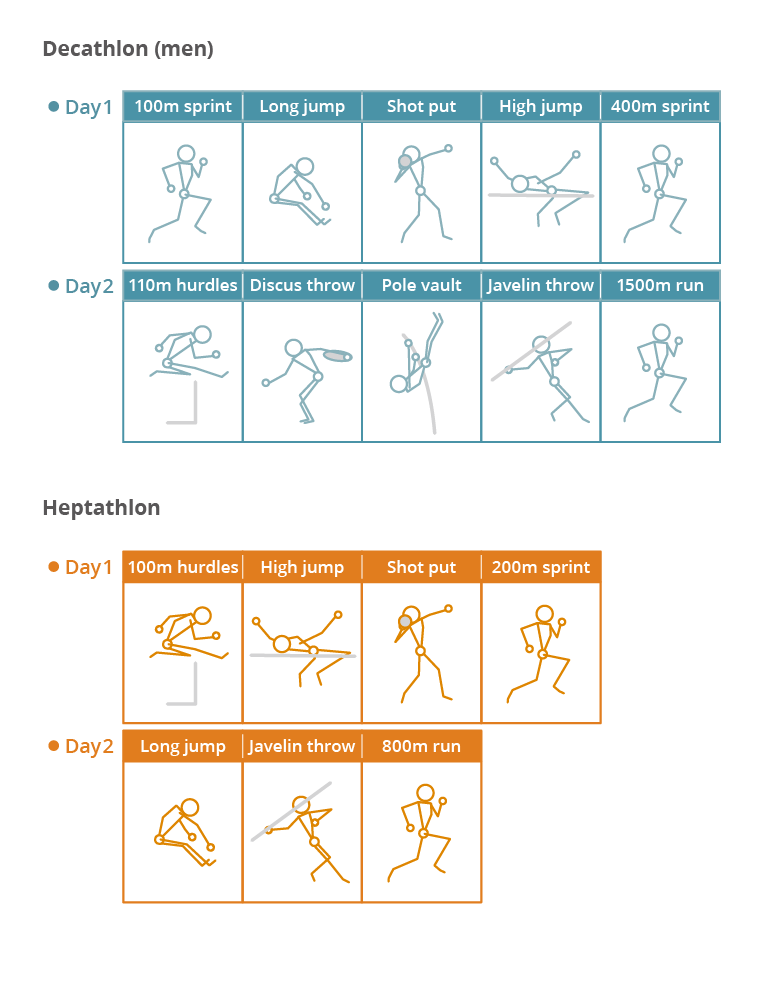
Their records (time and distance) are converted into points by designated conversion formulas, with the total score determining the ranking order.
The formulas are very complex, take for example the 100m sprint. It is calculated as score = 4347 x (18-T)1.81 [points], where T is the recorded time (second). This can be calculated using a scientific calculator, today apps for PCs and smartphones are available which calculate scores simply by entering the recorded times or distances. Here are the world’s top 10 decathlon records.
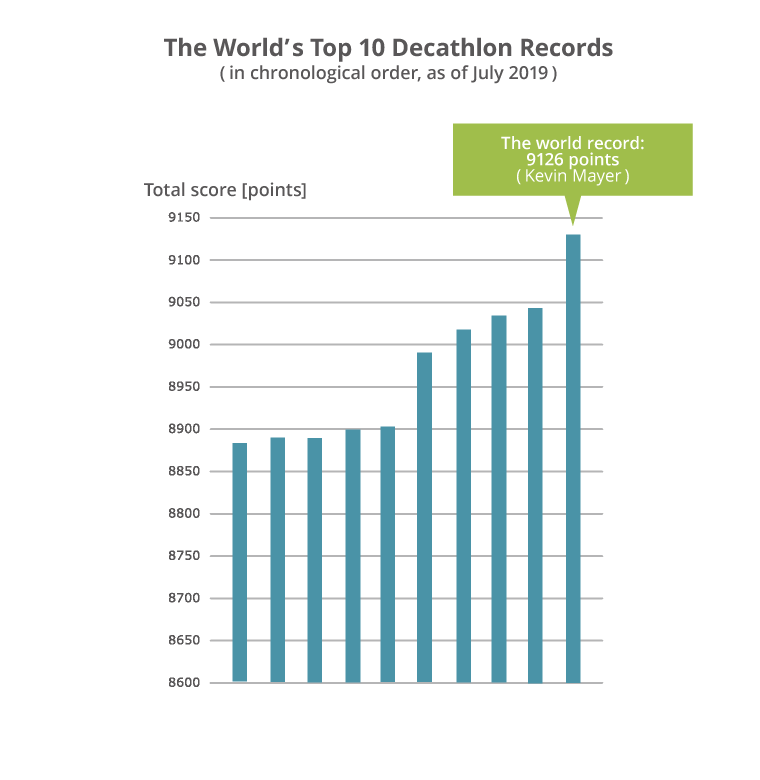
The current world record in the decathlon is 9126 points, achieved by Kevin Mayer in 2018. The previous world record was held by Ashton Eaton from IAAF World Athletics Championships Beijing 2015, where the new world record of 9045 points was achieved for the first time in 14 years. Mayer easily broke this record with his amazing points score, exceeding it by nearly 100 points.
While Mayer’s records in the short and middle-distance runs fell short of those of Eaton’s, his good results in the throwing events (shot put, discus and javelin throws), which he is strong in, considerably contributed to his overall score, allowing him to establish a new world record.
Take a look at the comparisons between his results (times and distances) from the championship and world records in each event. Although Mayer is good in the throwing events, the results were not even close to the world records of individual events. As he is still a young athlete, born in 1992, Mayer draws the world’s attention for his potential to further progress in the throwing events, and improve on his world record in the future.
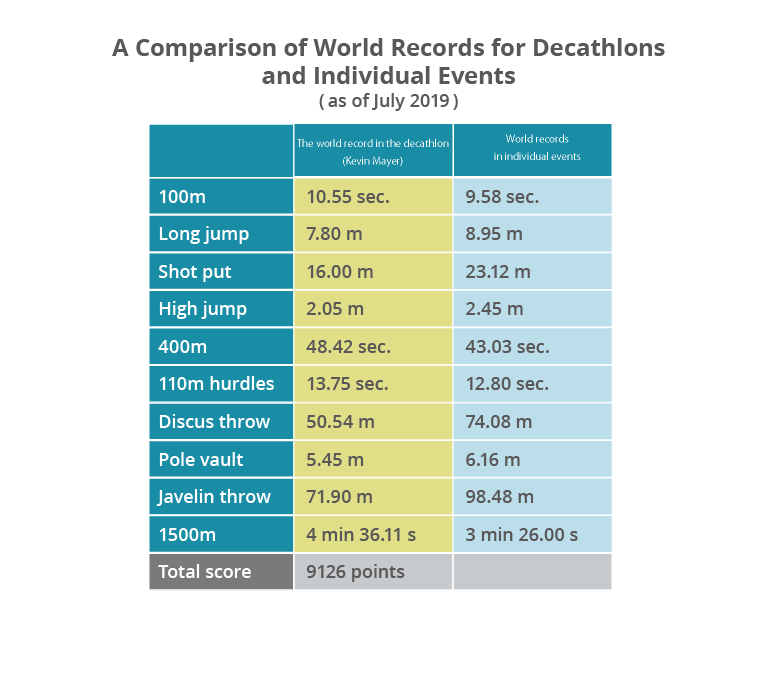
The world record in the heptathlon remains unbroken for over 30 years
Here are the women’s top 10 heptathlon records. In this sport the current world record is held by Jackie Joyner-Kersee, with 7291 points, which she achieved in 1988. The second best score is 7032 points by Carolina Klüft in 2007, lagging behind the world’s top by a staggering 259 points, which creates intrigue as to who is going to break this outstanding world record.
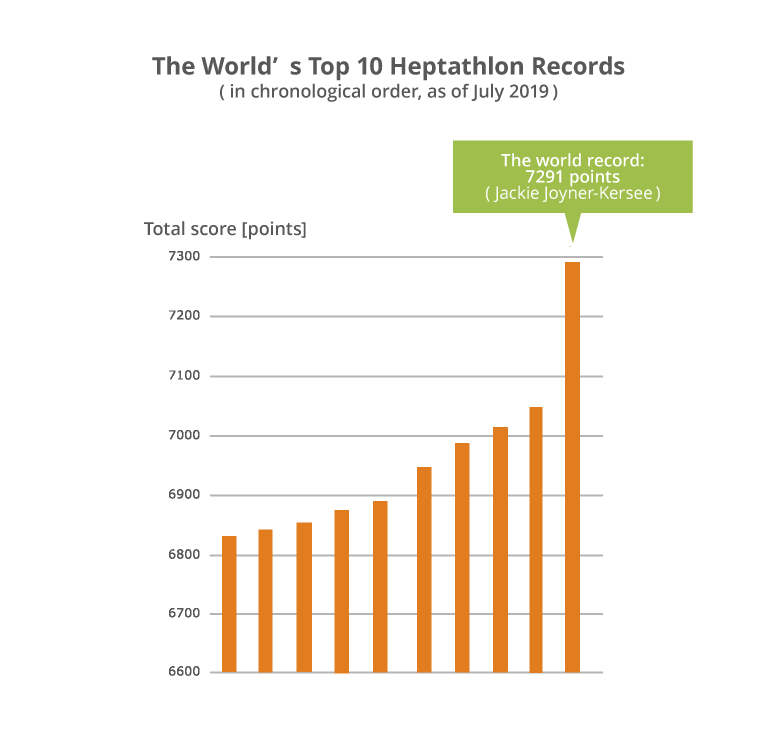
A stadium offers a unique experience of spectating at track and field events at one time
The decathlon and heptathlon both take place over two consecutive days in the same stadium. A stadium offers the unique experience of watching the track and field events simultaneously among other enthused spectators. Here is a simple illustration of an athletics stadium. Official stadiums where international and other important competitions take place are equipped with several areas for jumping and throwing events, allowing the competition areas to change according to the direction of the wind.
The longest distance throwing event is the javelin, which uses the entire length of the turfed field for throwing. The world record for a javelin throw is 98.48m held by Jan Železný (1996). You may think that it is just a question of time before we see the 100m mark broken, but in fact it was already achieved in 1984, when the world’s first over a 100 meters record was achieved (104.8m). However, it was felt that the turfed area would be too short if the record continued to grow over 100 meters, and so the rules were changed to shift the center of gravity of the javelin toward its front so that the flying distance would be shortened by about 10%. Today, the official world records for men and women are the ones achieved after 1986 and 1999 respectively.
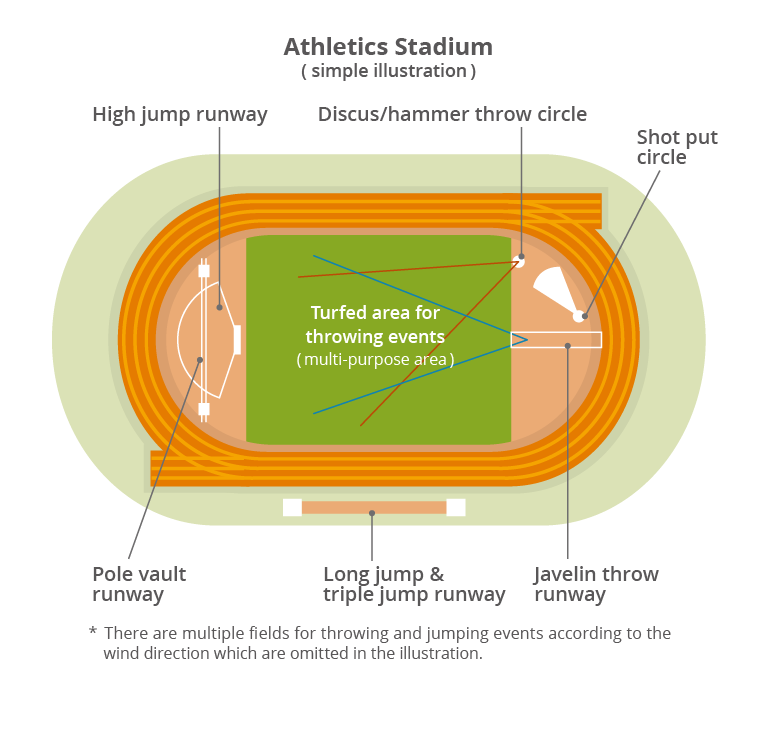
The last event of the decathlon and heptathlon is the middle distance run (men’s 1500m and women’s 800m), which is extremely hard for athletes physically as well as mentally, because the title of being the king or queen of athletes will be snatched away by others if they fail to beat competitors in the total score, even if they cross the finish line before everyone else. It is exciting to see in this race how athletes play out their strategies against rivals and squeeze out their remaining strength in their final spurt.
TDK’s sensors and sensing technology, supporting sports science and athletes’ healthcare
Growing efforts are being made to leverage sensors and sensing technology to improve sports such as track and field events efficiently and effectively. For example, motion sensors (acceleration sensors and angular velocity sensors) are employed to analyze athletes’ bodily movements and postures while biosensors measure their heartbeat, breathing, body temperature, perspiration and so on, so as to monitor their physical condition. Environmental sensors serve as a means of finding the correlation between performance and the environment by measuring the ambient temperature, humidity, and atmospheric pressure. The data can then be analyzed using artificial intelligence (AI) to explore further improvements in track and field events, as well as other sports.
Sensors and sensing technology are also used in devices such as active mass meters that record athletes’ daily training sessions.
TDK offers a wearable biosensor, the Silmee™ series, for collecting and managing vital data, such as the amount of exercise and pulse rate, by combining high-precision sensors and proprietary software and algorithms.
Silmee™ W22 is a wristband type active mass meter, equipped with an acceleration sensor, pulse sensor, temperature sensor, microphone, and an ultraviolet (UV) sensor. It can measure and record steps made while running or walking, the calories consumed during exercise, as well as the hours asleep, pulse rate, skin temperature, and the amount of UV rays. TDK’s unique algorithm enables the automatic recording of the hours spent sleeping using an acceleration sensor, which monitors the patterns of bodily movements during sleep, then automatically analyzes the monitoring data to determine whether the wearer is awake or sleeping.
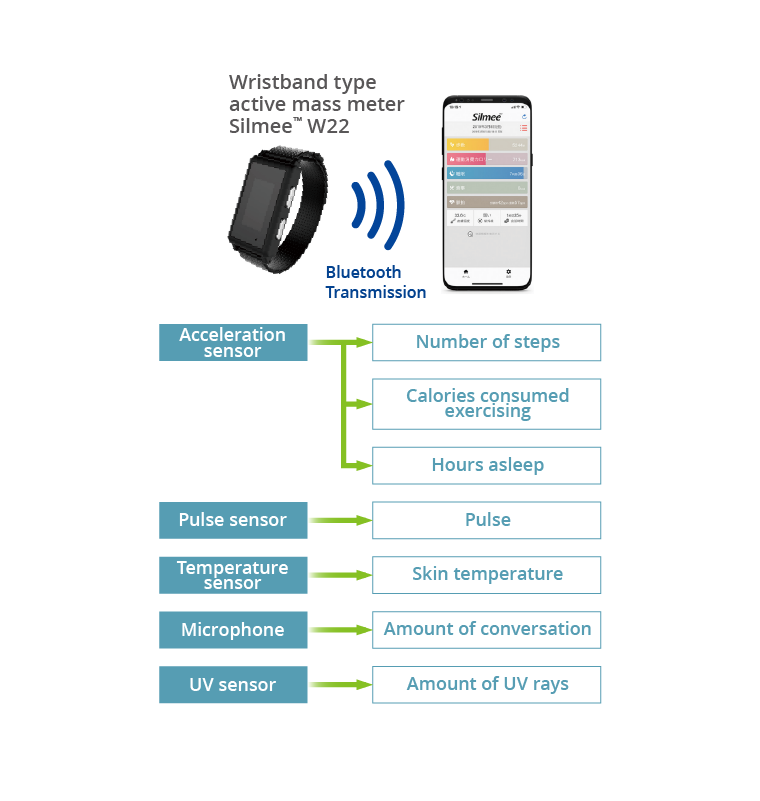
Wristband type active mass meter Silmee™ W22
The pulse meter, which operates 24 hours a day in real time, is based on a reflective photoelectric system using a green LED and photodiode. The green LED emits light onto the skin of the wrist, and the light receiving element, the photodiode, measures the light diffuse-reflection of the capillaries 1 to 2 mm deep under the skin.
The heartbeat dictates the dilation and contraction of the capillaries under the skin in the wrists, and the hemoglobin in the blood absorbs light. So, when the capillaries are dilated, there is more blood that runs through them, reducing the light that bounces back to the photodiode. Conversely, contracted capillaries allow more light to be reflected, since less blood runs through them. By wearing the device, a person’s pulse can be taken in real time 24/7. Continuous measurement of your pulse is useful to find out the exercise load optimal for your age. The device is thus a reliable tool to assist daily training and healthcare.
It is designed to fit various occasions and comes with an easy-to-read display. Fully charged it runs for 10 consecutive days. The device has a capacity to store about one month’s worth of active mass data (these figures are only estimates, and may vary depending on the conditions of use). The dedicated app, Silmee Connect, allows users to display and manage the vital data obtained through the sensors on their smartphones.
Silmee™
https://product.tdk.com/info/en/products/biosensor/biosensor/silmee_w11/index.html
Deciplines decathlon
https://www.iaaf.org/disciplines/combined-events/decathlon
Deciplines heptathlon
https://www.iaaf.org/disciplines/combined-events/heptathlon
TDK is a comprehensive electronic components manufacturer leading the world in magnetic technology



